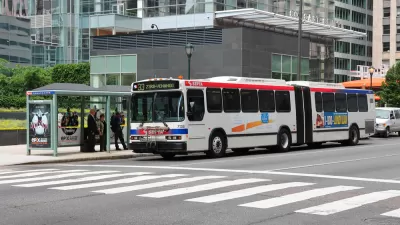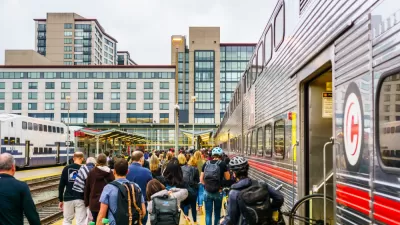The final infrastructure deal cutting by more than half the transit funding proposed in the American Jobs Plan.

As Congress finalized its infrastructure deal, writes Jeff Davis, the funding allocated to public transit shrank "from $85 billion (really $110 billion) in President Biden’s American Jobs Plan, down to $48.5 billion in the June bipartisan infrastructure 'framework,' to $39.2 billion in the final bipartisan infrastructure deal."
In the June 24 BIF, "President Biden and his team had signed off on a framework that reduced the total above-baseline funding for roads, bridges, and major projects by 31 percent ($49 billion) from the combined total in the original American Jobs Plan. But the White House had also endorsed a framework that reduced above-baseline funding for public transit from $110 billion (including the electric transit buses) to $48.5 billion, which was a 56 percent reduction from the original request."
Then, transit funding was slashed again by $4.4 billion. "This time the reduction came entirely from the general fund advance appropriations for the Federal Transit Administration, reducing that amount of money from $24.35 billion to $20.00 billion, and reducing the total above-baseline mass transit funding provided by the bill down to $39.2 billion."
"Transit advocates are looking to reopen the bipartisan bill by getting additional funding for mass transit as part of the budget reconciliation bill that will move through Congress in September and October." But if that happens, Davis writes, "members of the bipartisan Senate negotiating team might feel obligated to reopen the other parts of the bill that were negotiated in exchange for the lowered transit funding."
FULL STORY: How Transit Got Traded Away in the Bipartisan Infrastructure Deal

Planetizen Federal Action Tracker
A weekly monitor of how Trump’s orders and actions are impacting planners and planning in America.

Congressman Proposes Bill to Rename DC Metro “Trump Train”
The Make Autorail Great Again Act would withhold federal funding to the system until the Washington Metropolitan Area Transit Authority (WMATA), rebrands as the Washington Metropolitan Authority for Greater Access (WMAGA).

The Simple Legislative Tool Transforming Vacant Downtowns
In California, Michigan and Georgia, an easy win is bringing dollars — and delight — back to city centers.

The States Losing Rural Delivery Rooms at an Alarming Pace
In some states, as few as 9% of rural hospitals still deliver babies. As a result, rising pre-term births, no adequate pre-term care and "harrowing" close calls are a growing reality.

The Small South Asian Republic Going all in on EVs
Thanks to one simple policy change less than five years ago, 65% of new cars in this Himalayan country are now electric.

DC Backpedals on Bike Lane Protection, Swaps Barriers for Paint
Citing aesthetic concerns, the city is removing the concrete barriers and flexposts that once separated Arizona Avenue cyclists from motor vehicles.
Urban Design for Planners 1: Software Tools
This six-course series explores essential urban design concepts using open source software and equips planners with the tools they need to participate fully in the urban design process.
Planning for Universal Design
Learn the tools for implementing Universal Design in planning regulations.
Smith Gee Studio
City of Charlotte
City of Camden Redevelopment Agency
City of Astoria
Transportation Research & Education Center (TREC) at Portland State University
US High Speed Rail Association
City of Camden Redevelopment Agency
Municipality of Princeton (NJ)





























